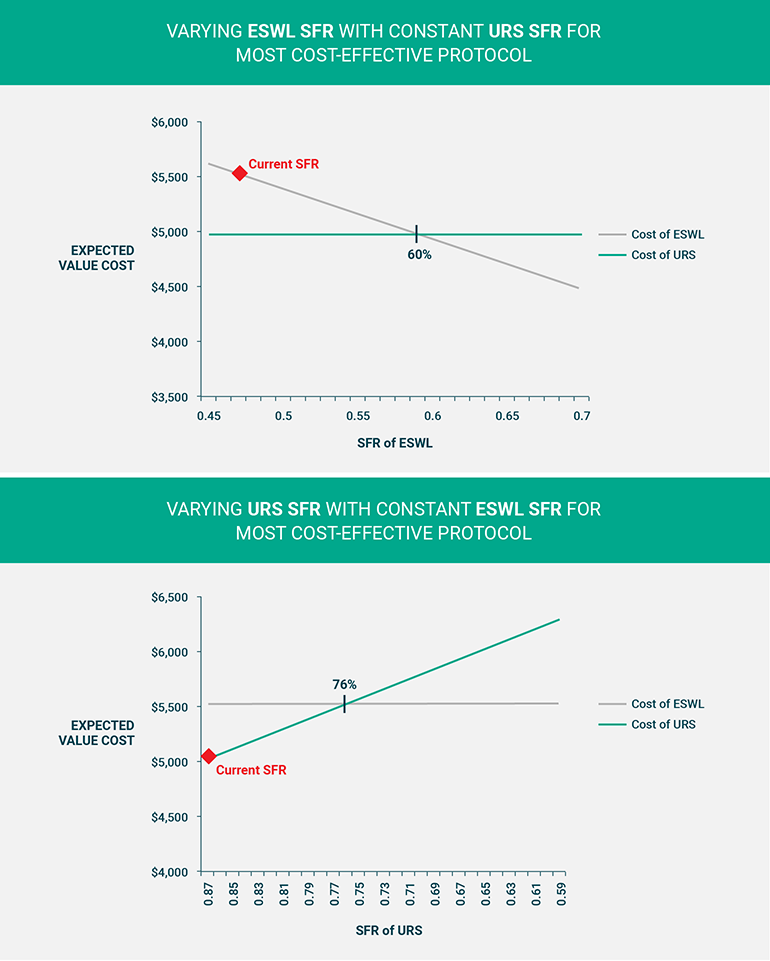New Model Evaluates Cost-Effectiveness of Treatment Modalities for Ureteral Stones
Key findings
- In a retrospective study at Massachusetts General Hospital, ureteroscopic (URS) laser lithotripsy had significantly greater stone-free rates than shock-wave lithotripsy (SWL) (89% vs. 47%)
- There were no major complications with either treatment modality
- URS was found to be the more cost-effective treatment if SWL is not successful more than 60–64% of the time or if URS is successful more than 57–76% of the time
According to the American Urological Association guidelines, shock-wave lithotripsy (SWL) is the procedure with the least morbidity and lowest complication rate, but URS is known to have a greater stone-free rate in a single procedure. In patients with mid or distal ureteral stones who require intervention (who were not candidates for or who failed medical expulsive therapy), clinicians should recommend URS as first-line therapy. For patients who decline URS, clinicians should offer SWL. However, the guideline does not include any information about how to weigh between the two procedures in terms cost-effectiveness.
Subscribe to the latest updates from Urology Advances in Motion
Urology Resident Michal Ursiny, MD, and Brian Eisner, MD, co-director of the Kidney Stone Program at Massachusetts General Hospital, and colleagues constructed a decision analysis model that demonstrated superior cost-effectiveness of URS under real-world conditions. As they report in World Journal of Urology, surgeons can use the model to assess the cost-effectiveness of SWL and URS in their own institutions.
The research team identified 113 patients who had elective treatment for ureteral stones <1.5 cm between June 2010 and July 2011. Of the 51 patients who underwent SWL, 24 (47%) were stone-free after the initial procedure, compared with 55 of 62 patients (89%) who underwent URS (p<.002).
Of the patients with residual stones, 15 in the SWL group (29%) and all seven in the URS group (11%) underwent additional procedures (p=.02). The other 12 patients in the SWL group had a low residual stone burden and chose watchful waiting.
There were no major complications in either group and no patient required readmission. Also, there was no significant difference between the two groups in overall complication rate.
To calculate the costs of the procedures, the researchers included the surgeon's fee, anesthesia fee, facility cost and cost of stent placement, where applicable. They did not include the imaging fee, because there was no significant difference between groups in the ratio of patients imaged with computed tomography versus x-ray. The average cost per procedure was $3,167 for SWL and $4,470 for URS.
Using this data, the researchers constructed three decision models to represent different surgeons' practice patterns: repeating SWL once, twice or three times before using URS. The models defined success as stone-free status, not symptomatic relief.
The modeling showed that URS was more cost-effective than SWL if:
- SWL is not successful at least 60% to 64% of the time
- URS is successful at least 57% to 76% of the time

Figure 1
Figure 1 is a sample of a cost-effectiveness curve that assumes SWL is performed twice before URS, which was the most cost-effective of the three models.
The researchers invite other surgeons to determine stone-free rates with SWL and URS using their own equipment and methods. They can then assess which procedure is more cost-effective at their institutions.
Patient preference should have a large influence on surgical decision-making, and the researchers emphasize that the choice between SWL and URS should not be based on cost alone. Still, now that MACRA (the Medicare Access and CHIP Reauthorization Act) aims to shift the U.S. health care system to value-based reimbursement, it will be worthwhile to focus more attention on cost-effective uses of resources.
view original journal article Subscription may be required
Learn more about Mass General's Kidney Stone Program
Refer a patient to the Kidney Stone Program